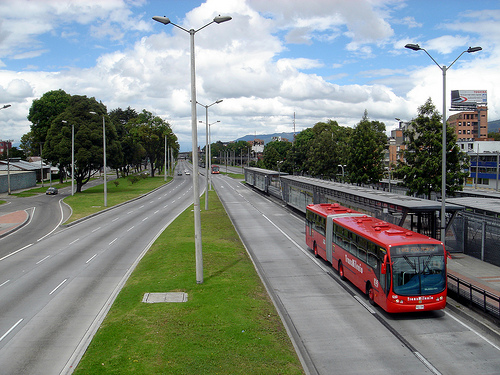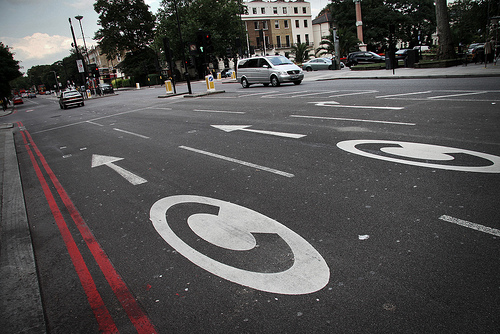Cars promise mobility, and in a largely rural setting they provide it. But in an urbanizing world, where more than half of us live in cities, there is an inherent conflict between the automobile and the city. After a point, as their numbers multiply, automobiles provide not mobility but immobility, as well as increased air pollution and the health problems that come with it. Urban transport systems based on a combination of rail lines, bus lines, bicycle pathways, and pedestrian walkways offer the best of all possible worlds in providing mobility, low-cost transportation, and a healthy urban environment.
 The Bogotá Bus Rapid Transit system is being replicated around the world.Photo courtesy Jorge Lascar via FlickrSome of the most innovative public transportation systems, those that shift huge numbers of people from cars into buses, have been developed in Curitiba, Brazil, and Bogotá, Colombia. The success of Bogotá’s Bus Rapid Transit (BRT) system, TransMilenio, which uses special express lanes to move people quickly through the city, is being replicated not only in six other Colombian cities but in scores elsewhere too, including Mexico City, São Paulo, Hanoi, Seoul, Istanbul, and Quito. By 2012, Mexico City plans to have 10 BRT lines in place.
The Bogotá Bus Rapid Transit system is being replicated around the world.Photo courtesy Jorge Lascar via FlickrSome of the most innovative public transportation systems, those that shift huge numbers of people from cars into buses, have been developed in Curitiba, Brazil, and Bogotá, Colombia. The success of Bogotá’s Bus Rapid Transit (BRT) system, TransMilenio, which uses special express lanes to move people quickly through the city, is being replicated not only in six other Colombian cities but in scores elsewhere too, including Mexico City, São Paulo, Hanoi, Seoul, Istanbul, and Quito. By 2012, Mexico City plans to have 10 BRT lines in place.
Beijing is one of 11 Chinese cities with BRT systems in operation. In southern China, Guangzhou officially opened its BRT in early 2010. Already carrying more than 800,000 passengers daily, this system is expected to serve one million passengers per day by the end of the year. In addition to linking with the city’s underground Metro in three places, it will soon be paralleled throughout its entirety with a bike lane. Guangzhou will also have 5,500 bike parking spaces for those using a bike-BRT travel combination.
In Iran, Tehran launched its first BRT line in early 2008. Several more lines are in the development stage, and all will be integrated with the city’s new subway lines. Several cities in Africa are also planning BRT systems. Even industrial-country cities such as Ottawa, Toronto, New York, Minneapolis, Chicago, Las Vegas, and — much to everyone’s delight — Los Angeles have launched or are now considering BRT systems.
Some cities are reducing traffic congestion and air pollution by charging cars to enter the city, including Singapore, London, Stockholm, and Milan. In London — where until recently the average speed of an automobile was comparable to that of a horse-drawn carriage a century ago — a congestion fee was adopted in early 2003. The initial £5 (about $8 at the time) charge on all motorists driving into the center city between 7 a.m. and 6:30 p.m. immediately reduced the number of vehicles, permitting traffic to flow more freely while cutting pollution and noise.
 Congestion lanes and fees in London have reduced congestion by 36 percent.Photo courtesy smif via FlickrIn the first year after the new tax was introduced, the number of people using buses to travel into central London climbed by 38 percent and vehicle speeds on key thoroughfares increased by 21 percent. In July 2005, the congestion fee was raised to £8. With the revenue from the congestion fee being used to upgrade and expand public transit, Londoners are steadily shifting from cars to buses, the subway, and bicycles. Since the congestion charge was adopted, the daily flow of cars and minicabs into central London during peak hours has dropped by 36 percent while the number of bicycles has increased by 66 percent.
Congestion lanes and fees in London have reduced congestion by 36 percent.Photo courtesy smif via FlickrIn the first year after the new tax was introduced, the number of people using buses to travel into central London climbed by 38 percent and vehicle speeds on key thoroughfares increased by 21 percent. In July 2005, the congestion fee was raised to £8. With the revenue from the congestion fee being used to upgrade and expand public transit, Londoners are steadily shifting from cars to buses, the subway, and bicycles. Since the congestion charge was adopted, the daily flow of cars and minicabs into central London during peak hours has dropped by 36 percent while the number of bicycles has increased by 66 percent.
In January 2008, Milan adopted a “pollution charge” of $14 on vehicles entering its historic center in daytime hours during the week. Other cities now considering similar measures include San Francisco, Turin, Genoa, Kiev, Dublin, and Auckland.
Paris Mayor Bertrand Delanoë, who was elected in 2001, inherited some of Europe’s worst traffic congestion and air pollution. He decided traffic would have to be cut 40 percent by 2020. The first step was to invest in better transit in outlying regions to ensure that everyone in the greater Paris area had access to high-quality public transit. The next step was to create express lanes on main thoroughfares for buses and bicycles, thus reducing the number of lanes for cars.
A third innovative initiative in Paris was the establishment of a city bicycle rental program that has 20,600 bikes available at 1,450 docking stations throughout the city. Access to the bikes is by credit card, with a choice of daily, weekly, or annual rates ranging from just over $1 per day to $40 per year. If the bike is used for fewer than 30 minutes, the ride is free. The bicycles are proving to be immensely popular — with more than 63 million trips taken as of late 2009.
At this point Mayor Delanoë is working hard to realize his goal of cutting car traffic by 40 percent and carbon emissions by a similar amount by 2020. The popularity of this bike sharing program has led to its extension into 30 of the city’s suburbs and has inspired cities such as London to also introduce bike sharing.
The United States, which has lagged far behind Europe in developing diversified urban transport systems, is being swept by a “complete streets” movement, an effort to ensure that streets are friendly to pedestrians and bicycles as well as to cars. Many American communities lack sidewalks and bike lanes, making it difficult for pedestrians and cyclists to get around safely, particularly where streets are heavily traveled.
This cars-only model is being challenged by the National Complete Streets Coalition, a powerful assemblage of citizen groups, including the Natural Resources Defense Council, AARP, and numerous local and national cycling organizations. Among the issues spurring the complete streets movement are the obesity epidemic, rising gasoline prices, the urgent need to cut carbon emissions, air pollution, and mobility constraints on aging baby boomers. The elderly who live in urban areas without sidewalks and who no longer drive are effectively imprisoned in their own homes.
The National Complete Streets Coalition reports that as of April 2010, complete streets policies are in place in 20 states, including California and Illinois, and in 71 cities. One reason states have become interested in passing such legislation is that integrating bike paths and sidewalks into a project from the beginning is much less costly than adding them later.
Closely related to this approach is a movement that encourages and facilitates walking to school. Beginning in the United Kingdom in 1994, it has now spread to some 40 countries, including the United States. Forty years ago, more than 40 percent of all U.S. children walked or biked to school, but now the figure is under 15 percent. Today 60 percent are driven or drive to school. Not only does this contribute to childhood obesity, but the American Academy of Pediatrics reports fatalities and injuries are much higher among children going to school in cars than among those who walk or ride in school buses. Among the potential benefits of the Walk to School movement is a reduction in obesity and early onset diabetes.
Countries with well-developed urban transit systems and a mature bicycle infrastructure are much better positioned to withstand the stresses of a downturn in world oil production than those that depend heavily on cars. With a full array of walking and biking options, the number of trips by car can easily be cut by 10-20 percent.
As the new century advances, the world is reconsidering the urban role of automobiles in one of the most fundamental shifts in transportation thinking in a century. The challenge is to redesign communities so that public transportation is the centerpiece of urban transport and streets are pedestrian- and bicycle-friendly. This also means planting trees and gardens and replacing parking lots with parks, playgrounds, and playing fields. We can design an urban lifestyle that systematically restores health by incorporating exercise into daily routines while reducing carbon emissions and eliminating health-damaging air pollution.
Adapted from Chapter 6, “Designing Cities for People” in Lester R. Brown, Plan B 4.0: Mobilizing to Save Civilization (New York: W.W. Norton & Company, 2009), available on-line at www.earthpolicy.org/index.php?/books/pb4




